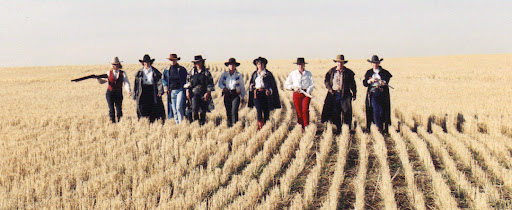Saturday, May 19, 2012
THE THIRD TOUGHEST ROPING
By Julie Carter
Fishing stories don’t hold a candle to roping tales. The big one always gets away and there is always some windy explanation about how it happened and what the result would be if it hadn’t.
This past weekend there was a sizable high class roping, and yes, I know, there will be some that will holler “oxymoron” over that description. I will argue that where team roping is concerned, the scales will most generally tip toward the moron than the high class, but I digress.
High dollar prizes and prestigious titles were at stake and the “big boys” of roping were there wearing the names of their corporate sponsors embroidered all over their shirts.
A plethora of dinner plate-sized belt buckles (sometimes referred to as gut shot prevention) were flashing proof of the skill level gathered at this event. These ropers had made the sport not a hobby, but their livelihood, their only interest in life and their passion.
As the roping progressed, so did the usual discussion about the cattle they were roping. The general consensus was that they were dirty, heavy and exceptionally fast. That summation led to remembrances of other ropings and the comparisons.
The pro-boys spoke of how the cattle were at Cheyenne last year, followed by remembrances of Reno, Calgary and even Las Vegas was given a good cussing.
Standing quietly among these roping legends was a cowboy that had come up the hard way in ranch country and now masqueraded as a full time team roper. He commented that indeed this was a “plenty tough roping.” However, he believed it was just his third toughest roping.
“It was branding time and we’d spent some long days gathering a bunch of wild crossbred cattle, mostly Brahma, that had never seen man or horse,” he explained. “We finally got most of them to the pens and they weren’t real friendly.
“We muscled them through the chute to brand them. There was one high-headed heifer that kept pushing her way to the back of the line. We finally got her worked up toward the front but when she got almost to the chute, she started pushing backward as far as she could, then took a run at the head gate and kept on going.”
With the head gate shut firmly around her neck, she tore it loose from the squeeze chute and took off like greased lightning across a six section rocky, rough pasture.
The cowboys scrambled for their horses, pulled their cinches, and in a single motion put their foot in their stirrup and left in hot pursuit with loops ready.
It took a while. A good number of the hands were riding green colts who were not about to get anywhere close to that monster scary thing wearing a head gate on her neck.
That was the toughest roping, he said.
Intrigued, someone asked about the second toughest roping.
“We were working cattle through the chute –shots, branding and fly-ban pour on down their backs. One of the hands poured the chemical on a steer just before the branding iron hit the hide and that long winter hair burst into flames,” he recalled.
The chute operator thought the thing to do was let the steer out. When he did, the steer left like a scalded dog, jumped the fence, and raced through a dry grass pasture, lighting the prairie on fire as he went.
Cowboys ran for their horses only to find their trusty mounts were decidedly reluctant to get within roping distance of a flaming steer running through flaming grass. That was the second toughest roping.
It was a glaring example of the adage “first liar doesn’t stand a chance.” But you have to know those ropers who had never made their living punching cattle had that visual “burned” into their minds. In the quiet hours of the night going down the road, they’d think again about the new measure for “the toughest roping.”
Subscribe to:
Posts (Atom)
